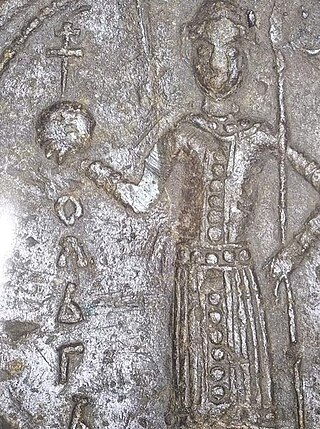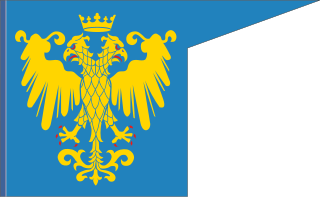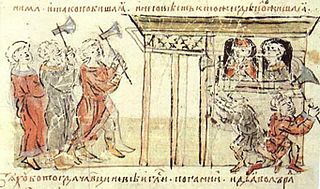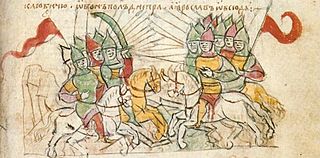
Vsevolod I Yaroslavich was Grand Prince of Kiev from 1078 until his death in 1093.

The Primary Chronicle, shortened from the common Russian Primary Chronicle, is a chronicle of Kievan Rus' from about 850 to 1110. It is believed to have been originally compiled in or near Kiev in the 1110s. Tradition ascribed its compilation to the monk Nestor beginning in the 12th century, but this is no longer believed to have been the case.

Oleg Svyatoslavich was a prince from Kievan Rus' whose equivocal adventures ignited political unrest in the country at the turn of the 11th and 12th centuries. He reigned as Prince of Chernigov from 1094 to 1097, and as Prince of Novgorod-Seversk from 1097 to 1115. He was the progenitor of the Olgovichi family.
Aepa is the name of at least two early 12th-century Cuman (Polovtsi) princes mentioned in Rus' chronicles.
The family of Vladimir I, popularly known as Vladimir the Great, prince of Kievan Rus', is subject to scholarly studies. The primary sources about his life, such as the Primary Chronicle and the Chronicon Thietmari of Thietmar of Merseburg, are legendary, and require critical scrutiny to separate fact from fiction.
Sveneld, is a semi-legendary 10th-century Varangian warlord in the service of Sviatoslav I and his family. Most of the information about Sveneld is scarce. He is described as a rich man and a voevoda of Kievan Rus', but his relation to the reigning Rurikid princes, if it existed, has not been positively established.

Boris Vyacheslavich was Prince of Chernigov for eight days in 1077. He was the son of Vyacheslav Yaroslavich, Prince of Smolensk. Following his father's death in 1057, the child Boris was debarred from his inheritance. He died fighting against his uncles—Vsevolod Yaroslavich, Prince of Chernigov and Izyaslav Yaroslavich, Grand Prince of Kiev—on 3 October 1078.
The Battle of Listven (1024) was part of the aftermath of the Kievan succession crisis of 1015–1019 following the death of Vladimir the Great (Volodymyr) in 1015. It was fought between his sons Mstislav of Chernigov and Kievan forces supporting Yaroslav the Wise; Mstislav defeated Yaroslav. The battle is mainly known from the account written under the year 6532 (1024) in the Primary Chronicle, completed about 90 years later. According to that legendary narrative, the battle took place at night during a thunderstorm.
The Prince of Pereyaslavl was the ruler of the Principality of Pereyaslavl, a lordship based on the city of Pereyaslavl on the Trubizh River, and straddling extensive territory to the east in what are now parts of Ukraine. It was situated on the southern frontier of Kievan Rus' and bordered the steppe.

The Principality of Peremyshl was a medieval petty principality centred on Peremyshl in the Cherven lands.
Malfrida or Malfrid is the name of a woman who died in 1000 according to the Primary Chronicle (PVL).
Roman Svyatoslavich or Roman the Handsome was prince of Tmutarakan in Kievan Rus'. The starting year of his reign is uncertain, but he reigned his principality from around 1073 or 1077. His former allies, the Cumans killed him after their unsuccessful joint campaign against his uncle, Vsevolod I of Kiev.
Vyacheslav Yaroslavich or Viacheslav Yaroslavich was the Prince of Smolensk from 1054 until his death in 1059.

Theodore the Varangian and his son John are the names traditionally attributed to a Varangian Christian man from Greece and his young son living in Kiev, who were killed in a story recorded in the Primary Chronicle under the year 6491 (983). The chronicle glorifies their deaths as examples of Christian martyrs who suffered persecution by the pagan establishment of Kievan Rus' during the reign of prince Vladimir the Great.

The Council of Uvetichi consisted of two meetings of the senior generation of princes of Kievan Rus'. It took place in August 1100, and it had a twofold purpose: to bring about a reconciliation among the princes and to pass judgment on Prince Davyd Igorevich. The venue of the conference was the town of Uvetichi, which is on the right bank of the Dnieper not far from Kiev. It is now the village of Vytachiv in the Kyiv Oblast.
The Kiev uprising was a revolt by the inhabitants of Kiev and nearby cities, to remove the Polish occupying force of Bolesław I the Brave from their territories. It was reportedly provoked when Bolesław (Boleslav) did not transfer to Sviatopolk I of Kiev his right to the throne of Kiev, but instead installed Polish garrisons. The uprising is disputed by Polish historians, as it is not mentioned in the Chronicon of Thietmar of Merseburg, although it does appear in the Russian Primary Chronicle.

The Battle of the Alta River was a battle that took place on 24 July 1019 between the troops of the Novgorodian prince Yaroslav "the Wise" Volodimerovich and the army of his brother, prince Sviatopolk I of Kiev, who was supported by the Pechenegs. It was part of the Kievan succession crisis of 1015–1019.

The Feud of the Sviatoslavichi was a war of succession in Kievan Rus' in the late 970s, between the sons of the Kievan prince Sviatoslav I Igorevich, for 'eldership' after the death of their father.

The Battle of Liubech (1016) was a clash between the troops of Sviatopolk and his brother Yaroslav near the town of Liubech. It was part of the Kievan succession crisis of 1015–1019 that broke out between the brothers after the death of prince Volodimer I of Kiev (1015).

The Council of Dolobsk is one of the significant stages in the attempts of the princes of Kievan Rus' to stop their internal quarrels, and unite their efforts in the face of the Cuman (Polovtsi) threat. According to the Primary Chronicle (PVL), it took place in early 1103 (6611) at the Lake of Dolobsk, somewhere near Kiev. The Hypatian Codex continuation of the PVL reports a very similar Council of Dolobsk between the same people, with only slight differences in wording, but taking place in the year 1111 (6619) instead; this might be an accidental duplication of the earlier narrative sub anno 1103 (6611).











